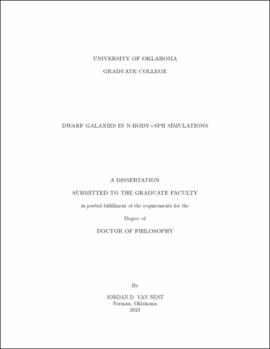| dc.contributor.advisor | Munshi, Ferah | |
| dc.contributor.author | Van Nest, Jordan | |
| dc.date.accessioned | 2023-12-05T20:00:26Z | |
| dc.date.available | 2023-12-05T20:00:26Z | |
| dc.date.issued | 2023-12 | |
| dc.identifier.uri | https://hdl.handle.net/11244/339998 | |
| dc.description.abstract | I present a study of various dwarf galaxies from N-body+SPH simulations in Lambda Cold Dark Matter cosmology. While the science results of this thesis pertain to dwarf galaxies of varying classifications and environments, I maintain a focus on how variations in definition and 3D-orientation affect these results. In a study of ultra-diffuse galaxies (UDGs), I show that those found in isolation are morphologically distinct from their non-UDG counterparts, a tracer of their unique formation channel through early, high-spin mergers. Randomly orienting and projecting our galaxies onto the 2D plane, however, removes any distinction between isolated UDGs and non-UDGs, suggesting that this difference will be difficult to detect with observations. Additionally, comparing various UDG definitions used in current literature shows that the number of UDGs identified in our simulations can vary drastically based on one's choice of definition, a result that is further complicated when considering various 3D orientations. More permissive definitions, that result in a large number of UDGs, tend to homogenize the UDG and non-UDG populations, erasing any observable distinction that may have existed.
I also present a study of study of Milky Way like galaxies and their satellite distributions, with a focus on comparing our results to the Satellites Around Galactic Analogs (SAGA) and Exploration of Local VolumE Satellites (ELVES) surveys. I show that host mass is a driving factor in both satellite accumulation and satellite quenched fraction, while host environment may have significant impact in extreme isolation. This impact can vary in strength depending on the criteria one uses to identify both the Milky Way analogs and their satellites. While the SAGA and ELVES surveys show conflicting results in regards to quenched fraction, I show that this discrepancy originates in low-mass satellites, as restricting quenching analysis to high mass satellites shows good agreement between our simulation and both observational surveys.
Finally, I present a study of morphology measurements for dwarfs in high-resolution zoom-in simulations. In comparing the observation-based method of isophote fitting to the simulation-based method of shape tensor calculation, I show that isophote fitting tends to imply more elongated shapes than shape tensor calculations, and this discrepancy is stronger at more edge-on orientations. I also implement observation-based methods of 3D shape inference presented in current literature to see how they compare to shape tensor calculation. I show that while these inference methods well recover our sample space and our in good qualitative agreement, there is some decent scatter on a galaxy-to-galaxy basis. All methods, however, independently imply that our simulations contain an oblate, high-mass population of satellite galaxies. | en_US |
| dc.language | en_US | en_US |
| dc.rights | Attribution-NoDerivatives 4.0 International | * |
| dc.rights.uri | https://creativecommons.org/licenses/by-nd/4.0/ | * |
| dc.subject | Galaxy Formation/Evolution | en_US |
| dc.subject | N-body Simulations | en_US |
| dc.subject | Dwarf Galaxies | en_US |
| dc.subject | Physics, Astronomy and Astrophysics | en_US |
| dc.title | Dwarf galaxies in N-body+SPH simulations | en_US |
| dc.contributor.committeeMember | Kilic, Mukremin | |
| dc.contributor.committeeMember | Dai, Xinyu | |
| dc.contributor.committeeMember | Kaib, Nathan | |
| dc.contributor.committeeMember | Sellers, Ian | |
| dc.contributor.committeeMember | Ruyle, Jessica | |
| dc.contributor.committeeMember | Tremmel, Michael | |
| dc.date.manuscript | 2023-12 | |
| dc.thesis.degree | Ph.D. | en_US |
| ou.group | Dodge Family College of Arts and Sciences::Homer L. Dodge Department of Physics and Astronomy | en_US |
| shareok.orcid | 0000-0003-3789-3722 | en_US |

